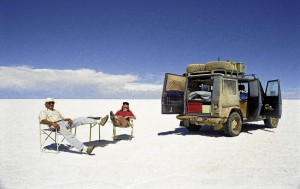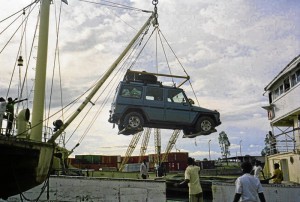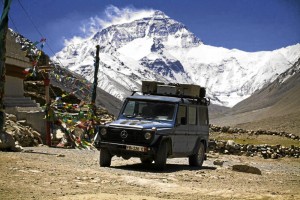Unmasking of ’Otto’
His ride’s name is made up of only two letters, but 74-year-old German Gunther Holtorf has gone 800,000 km through 199 countries inside his 1988 Mercedes-Benz 300GD, which he fondly calls “Otto.” He has spent 23 years inside Otto, the first 20 alongside his wife, Christine, before she passed away. Gunther’s journey continues with his sturdy G-Class, which is constantly 500 kg overweight because of the 400 spare parts and personal effects Gunther can’t do without. Yet, despite being an overburdened beast, Otto has survived some of the most extreme driving conditions this planet could dish out—the Amazon Forest, African desert, the environs of Mt. Everest, and Siberia. Gunther and his enduring Otto have even been able to part the political “iron curtains,” being the first and only foreign car setting foot, (or treads) on North Korea and Cuba. Here’s Otto, according to its intrepid owner:
What do you love about Otto? After 23 years behind the wheel, what can you say about its durability?
Otto runs only on “nuts and bolts,” no electronic gimmicks. It’s extremely sturdy, the engine is very reliable and long-lasting without charger. The “box style” body offers a lot of space inside, while looking small from the outside. It has perfect offroad capabilities. It is one of the most durable 4x4s.
What 4×4 vehicles would you consider its closest competitors?
The older Toyotas are also very good. The same applies to the Land Rover. However, I doubt that competitors would be in such shape after 800,000 km.
What would you wish that the modern G Class and GLK Class would have?

GUNTHER relaxing at the desert with his now deceased wife Christine in one of their travels. CONTRIBUTED PHOTO
The modern G and GLK classes are entirely different. The modern versions are all about power and electronics. The entire drive train, however, is also perfect in the new G Class, and makes that car number one for off-road.
What’s Otto’s downside?
Until 1989 the front-wheel bearings were slightly under-dimensioned.
Can you share some key specs of Otto?
• 3000 ccm diesel engine, five cylinder in-line, no charger
• mechanical injection pump
• 2,100 kg curb weight, our loaded weight up to 3300 kg
• 2-wheel drive, manually changeable to 4-wheel plus transfer case, giving 100 percent additional power at 50 percent reduced speed. Both can be activated while in motion.
What has been the cost of owning and operating your G class?
I apply preventive maintenance, which is more expensive but helps avoid many unforeseen problems. This costs me approximately 3,000 euros for every 100,000 km (mostly for shipping, hotels and other miscellaneous expenses).
What part in the Benz Museum will Otto be placed once it is retired?
It has been considered to be placed as a “showpiece” in the entrance or other prominent area.
Where in the world do you still need to go to?
Some 40,000 km still missing, thus completing the tour with 850,000 km. The next country is Japan and some other African countries.
What were the most important lessons in life you learned in 800,000 km of driving?
Three lessons: The world already is overpopulated; population is still growing at an alarming rate in those countries that already are incapable of satisfying their population’s needs; and all of today’s major world problems—scarcity of water and resources, climate change, pollution, and ecological imbalance—are only consequences of the first two.
What makes the Philippines different from other countries that you’ve visited?
The extremely friendly and helpful people.
The rather peculiar and unique form of public transport. I have seen motobikes with six people, up to 15 people in/on a tricycle and nearly 40 in/on a jeepney many of them actively working their mobile phones.
The many signboards calling for “Don’t text and drive” may only be seen in the Philippines. It appears that half of the population is always texting the other half.
The most memorable places: Sagada/Bontoc/Banawe with the unbelievable rice terraces.


